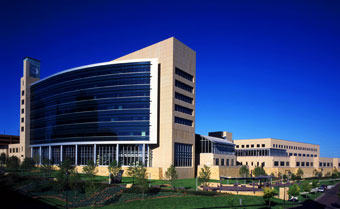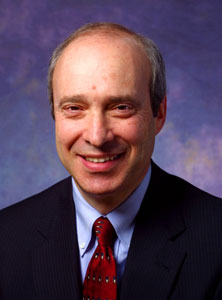Greater than the Sum
Greater than the Sum

Developing
good economic policy is a subtle art. It necessitates pulling together
the right minds with the proper training, and providing an environment
that focuses effort but allows freedom to innovate. At its best, the
environment will be a nexus between theorists and policymakers where
the flow of ideas sharpens both. In Minneapolis, that creative process
is at work in a partnership between the Department of Economics at the
U and the Federal Reserve Bank of Minneapolis.
For over a quarter of a century, economists and economics graduate students have shuttled back and forth between the Federal Reserve bank in downtown Minneapolis and the economics department on the West Bank. The physical commute is hardly a mile, but over the years these economists have spanned conceptual ground from early papers on rational expectations to current debates over international trade.
The Minneapolis partnership has been remarkably fertile, both in the development of economic theory and in moving that theory into the public arena. While it might be viewed as a simple exchange of expertise, at a deeper level the relationship is one of mutual transformation, a partial merging of interests and identity that has led, fundamentally, to a whole greater than the sum of its parts.
Seeds of collaboration
The parts, from the U's standpoint, are faculty and students who devote a portion of their time to work at the Minneapolis Fed. Well over half the active U of M economics professors are (or recently were) staff, consultants, or long-term visitors to the Fed's research department. And at any given time, a dozen or so graduate students populate cubicles on the Fed's seventh floor.The bank provides modest stipends and assistance to students and professors, as well as the invaluable research commodities of time, space, and silence. "It's the kind of place," recalls Lee Ohanian, a former U of M associate professor and Fed visitor, now at UCLA, "where you can walk in the door at 8 o'clock on a Monday morning, decide you want to spend the next eight hours on uninterrupted research, and be able to do it. That makes all the difference in the world."
In return, University scholars collaborate with staff economists at the Fed, focus on current policy questions, discuss macro theory with bank officials, and contribute to ongoing debates over the future direction of monetary and fiscal policy. The substantial overlap has borne fruit in the form of research focusing directly and indirectly on Fed policy questions.
Seeds of revolution
Ironically, the first joint effort between the U and the Fed succeeded only after it failed. The seed of the Minneapolis partnership was a "special studies group" formed in 1970 by John Kareken, then a professor of economics at the U and adviser to the Minneapolis Fed. The group's purpose: to build a better model for predicting an economy's behavior.Kareken brought in Neil Wallace, Thomas Muench, and Thomas Sargent, all University economists at the time. A year into the work, the group received a draft of a paper from a colleague, economist (and future Nobel laureate) Robert Lucas. "It was a difficult paper," Wallace recalls, "very different from things I was used to reading. ... [And] I knew that it cut away the underpinnings of what we'd been doing."
Indeed it did. Lucas' work was a fundamental critique of economic modeling. The effects of changes in economic policy couldn't be accurately predicted on the basis of past behavior, Lucas argued, because changing the rules of the economic game alters the behavior of players in the game.
This theory of "rational expectations" was a powerful criticism of conventional macroeconomics, and in the spring of 1973, the U/Fed research team scrapped its model-building. "We were stunned into terminating our long-standing Minneapolis Fed research project," Sargent later wrote. And the researchers immersed themselves in rational expectations, generating a flurry of academic papers that would later be termed a theoretical "revolution."

But
without the University's link to the Federal Reserve, theory might not
have informed practice for decades. "The literature on rational
expectations began well before our partnership did," notes Arthur
Rolnick (Right), senior vice president and director of research at the
Minneapolis Fed, and himself a U of M Ph.D. ('73). "But it likely would
not have gotten into the policy arena as quickly as it did if this
research weren't going on here, if it had been left in the
universities." Minneapolis Fed officers brought the idea to Federal
Reserve meetings and it slowly began to influence Fed policymaking.
Beyond expectations
Other joint efforts between the U's Department of Economics and the Federal Reserve have followed a similiar path. Work by Kareken and Wallace on deposit insurance, for instance, has provided a basis for banking policy. In the 1980s, University and Fed economists jointly developed vector autoregression (VAR) models now used for economic forecasting by the Fed and others.The celaboration of real business cycle analysis by former University Regents professor and Fed adviser Edward Prescott provided the dynamic general equilibrium model that is now standard macro methodology. Tim Kehoe, a University economist and Fed scholar, also played a major role in developing these models. And time inconsistency theory developed by Prescott, V.V. Chari, Finn Kydland, and Patrick Kehoe--all current or former professors at the University and advisers to the Fed--helps guide current central bank commitments to low inflation. In 2004, Prescott and Kydland shared the Nobel prize in economics for their work on time inconsistency policy and real business cycles.
U/Fed economists continue to develop cutting edge theory. For example, Sam Kortum, a U professor and Fed visitor, is developing pioneering models of international trade; his research won a prestigious Frisch Medal last year for its innovative econometric work. U faculty members Michele Boldrin, Larry Jones, and Mariacristina De Nardi, all visitors at the Fed, have just issued a paper examining the links between fertility and social security, suggesting that government pension programs may reduce childbearing by decreasing the need for support from one's children in old age.
Theories like these are honed each summer in Minneapolis at the annual macroeconomic workshop jointly sponsored by the Fed and the U--yet another facet of the partnership--which draws economists from around the world to try out new ideas or continue old debates. At this year's workshop, Fed senior economist Ellen McGrattan (yes, she teaches at the U as well) will revisit VARs, along with collaborators V.V. Chari and Pat Kehoe, arguing that while they may be valuable for economic forecasting, they have severe drawbacks when used for making monetary policy or for understanding the actual structural relationships of an economy.
Indeed, economists who have been part of the partnership stress that the Fed's real world problems provide focus for University theoretical work. "Economics lives on applied problems," notes Thomas Sargent, now at New York University. "In terms of infusing the macro part of the department with interesting policy questions, [the bank] is just a gold mine."
And it clearly isn't a one-way street. "There have been immense benefits to the management of the bank," says Sargent, whose own paper on VARs was also presented at the U/Fed macro workshop. "The bank president gains access to worldclass macroeconomists that he can talk to on a day-to-day basis, just by walking down the hall."
Of course, it's not only economists and policymakers who benefit. The graduate students who share in the collaboration are also exposed not only to the the research facilities of the Fed but also to the thorny realities of Fed policymaking and the rigor of frequent "bag lunch seminars," at which working papers-- including some by students--are critiqued in a process that, to the uninitiated, looks like a gauntlet with equations.
"A lot of what the students get from being at the Fed, aside from good food and a nice view of the Mississippi," jokes Rolnick, "is exposure to applying economics. Economic theory and research come alive here because we use them every day on policy questions. Moreover, students get to interact regularly with some of the world's best economists here at the Fed. When students sit elbowto- elbow in the cafeteria with Nobel laureates and future laureates, it inevitably stimulates ideas, inspires work, and builds relationships that last a lifetime."
The future
The Minneapolis partnership has helped to generate path-breaking theory and cogent policy. Academics have moved beyond the walls of the academy, and policymakers have had the benefit of their insight. It's probably fair to say that neither institution would have been as innovative or influential had it not sustained the relationship over the last three decades.As Rolnick comments, "The key to the Minneapolis Fed's influence on national policy issues is our longstanding partnership with the U of M economics department. For over 30 years, [this partnership has] resulted in major breakthroughs in macroeconomic and monetary theories that have had important implications for how a central bank should pursue its objectives."
Where will this partnership stand in a decade? From the University's perspective, the collaboration should endure. "If the Fed weren't in Minneapolis," says David Metzen, U of M Regent, "if this relationship didn't exist, the University would be all the poorer for it. This is precisely how government, business, and education ought to work together."
The Fed remains committed as well, and Rolnick is optimistic: "Five years ago I thought it couldn't get better, and it has."
June 24th, 2008